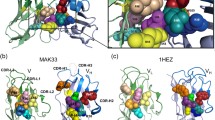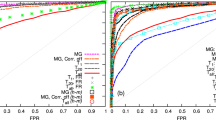Abstract
Adaptive immunity specifically protects us from antigenic challenges. Antibodies are key effector proteins of adaptive immunity, and they are remarkable in their ability to recognize a virtually limitless number of antigens. Fragment variable (FV), the antigen-binding region of antibodies, can be split into two main components, namely, framework and complementarity determining regions. The framework (FR) consists of light-chain framework (FRL) and heavy-chain framework (FRH). Similarly, the complementarity determining regions (CDRs) comprises of light-chain CDRs 1–3 (CDRs L1–3) and heavy-chain CDRs 1–3 (CDRs H1–3). While FRs are relatively constant in sequence and structure across diverse antibodies, sequence variation in CDRs leading to differential conformations of CDR loops accounts for the distinct antigenic specificities of diverse antibodies. The conserved structural features in FRs and conformity of CDRs to a limited set of standard conformations allow for the accurate prediction of FV models using homology modeling techniques. Antibody structure prediction from its amino acid sequence has numerous important applications including prediction of antibody-antigen interaction interfaces and redesign of therapeutically and biotechnologically useful antibodies with improved affinity. This chapter summarizes the current practices employed in the successful homology modeling of antibody variable regions and the potential applications of the generated homology models.
Access this chapter
Tax calculation will be finalised at checkout
Purchases are for personal use only
Similar content being viewed by others
References
Chi X, Li Y, Qiu X (2020) V(D)J recombination, somatic hypermutation and class switch recombination of immunoglobulins: mechanism and regulation. Immunology 160:233–247
Bansia H, Bagaria S, Karande AA, Ramakumar S (2019) Structural basis for neutralization of cytotoxic abrin by monoclonal antibody D6F10. FEBS J 286:1003–1029
Gowthaman R, Guest JD, Yin R, Adolf-Bryfogle J, Schief WR, Pierce BG (2020) CoV3D: a database of high resolution coronavirus protein structures. Nucleic Acids Res 49:282–287
Tortorici MA, Beltramello M, Lempp FA, Pinto D, Dang HV, Rosen LE et al (2020) Ultrapotent human antibodies protect against SARS-CoV-2 challenge via multiple mechanisms. Science 370:950–957
Wajnberg A, Amanat F, Firpo A, Altman DR, Bailey MJ, Mansour M et al (2020) Robust neutralizing antibodies to SARS-CoV-2 infection persist for months. Science 370:1227–1230
Hurlburt NK, Seydoux E, Wan YH, Edara VV, Stuart AB, Feng J et al (2020) Structural basis for potent neutralization of SARS-CoV-2 and role of antibody affinity maturation. Nat Commun 11(1):5413
Piccoli L, Park YJ, Tortorici MA, Czudnochowski N, Walls AC, Beltramello M et al (2020) Mapping neutralizing and immunodominant sites on the SARS-CoV-2 spike receptor-binding domain by structure-guided high-resolution serology. Cell 183:1024–1042
Barnes CO, Jette CA, Abernathy ME, Dam KA, Esswein SR, Gristick HB et al (2020) SARS-CoV-2 neutralizing antibody structures inform therapeutic strategies. Nature 588:682–687
Yuan M, Wu NC, Zhu X, Lee CD, So RTY, Lv H et al (2020) A highly conserved cryptic epitope in the receptor binding domains of SARS-CoV-2 and SARS-CoV. Science 368:630–633
Bansia H, Mahanta P, Yennawar NH, Ramakumar S (2021) Small glycols discover cryptic pockets on proteins for fragment-based approaches. J Chem Inf Model 61:1322–1333
Shirai H, Ikeda K, Yamashita K, Tsuchiya Y, Sarmiento J, Liang S et al (2014) High-resolution modeling of antibody structures by a combination of bioinformatics, expert knowledge, and molecular simulations. Proteins 82:1624–1635
Almagro JC, Teplyakov A, Luo J, Sweet RW, Kodangattil S, Hernandez-Guzman F et al (2014) Second antibody modeling assessment (AMA-II). Proteins 82:1553–1562
Surendranath K, Karande AA (2008) A neutralizing antibody to the a chain of abrin inhibits abrin toxicity both in vitro and in vivo. Clin Vaccine Immunol 15:737–743
Bagaria S, Ponnalagu D, Bisht S, Karande AA (2013) Mechanistic insights into the neutralization of cytotoxic abrin by the monoclonal antibody D6F10. PLoS One 8(7):e70273
Georgiou G, Ippolito GC, Beausang J, Busse CE, Wardemann H, Quake SR (2014) The promise and challenge of high-throughput sequencing of the antibody repertoire. Nat Biotechnol 32:158–168
Kuroda D, Shirai H, Jacobson MP, Nakamura H (2012) Computer aided antibody design. Protein Eng Des Sel 25:507–521
Kaplon H, Muralidharan M, Schneider Z, Reichert JM (2020) Antibodies to watch in 2020. MAbs 12(1):1703531
Lippow SM, Wittrup KD, Tidor B (2007) Computational design of antibody-affinity improvement beyond in vivo maturation. Nat Biotechnol 25:1171–1176
Sivasubramanian A, Sircar A, Chaudhury S, Gray JJ (2009) Toward high-resolution homology modeling of antibody Fv regions and application to antibody-antigen docking. Proteins 74:497–514
Pedotti M, Simonelli L, Livoti E, Varani L (2011) Computational docking of antibody-antigen complexes, opportunities and pitfalls illustrated by influenza hemagglutinin. Int J Mol Sci 12:226–251
Correia BE, Bates JT, Loomis RJ, Baneyx G, Carrico C, Jardine JG et al (2014) Proof of principle for epitope-focused vaccine design. Nature 507:201–206
Hoos A, Ibrahim R, Korman A, Abdallah K, Berman D, Shahabi V et al (2010) Development of ipilimumab: contribution to a new paradigm for cancer immunotherapy. Semin Oncol 37:533–546
Callahan MK, Wolchok JD, Allison JP (2010) Anti-CTLA-4 antibody therapy: immune monitoring during clinical development of a novel immunotherapy. Semin Oncol 37:473–484
Yasunaga M (2020) Antibody therapeutics and immunoregulation in cancer and autoimmune disease. Semin Cancer Biol 64:1–12
Hafeez U, Gan HK, Scott AM (2018) Monoclonal antibodies as immunomodulatory therapy against cancer and autoimmune diseases. Curr Opin Pharmacol 41:114–121
Norman RA, Ambrosetti F, Bonvin AMJJ, Colwell LJ, Kelm S, Kumar S et al (2020) Computational approaches to therapeutic antibody design: established methods and emerging trends. Brief Bioinform 21:1549–1567
Chiu ML, Goulet DR, Teplyakov A, Gilliland GL (2019) Antibody structure and function: the basis for engineering therapeutics. Antibodies 8(4):55
Wu TT, Kabat EA (1970) An analysis of the sequences of the variable regions of Bence Jones proteins and myeloma light chains and their implications for antibody complementarity. J Exp Med 132:211–250
Padlan EA (1994) Anatomy of the antibody molecule. Mol Immunol 31:169–217
Hayes JM, Cosgrave EF, Struwe WB, Wormald M, Davey GP, Jefferis R et al (2014) Glycosylation and Fc receptors. Curr Top Microbiol Immunol 382:165–199
Collis AV, Brouwer AP, Martin AC (2003) Analysis of the antigen combining site: correlations between length and sequence composition of the hypervariable loops and the nature of the antigen. J Mol Biol 325:337–354
North B, Lehmann A, Dunbrack RL (2011) A new clustering of antibody CDR loop conformations. J Mol Biol 406:228–256
Al-Lazikani B, Lesk AM, Chothia C (1997) Standard conformations for the canonical structures of immunoglobulins. J Mol Biol 273:927–948
Adolf-Bryfogle J, Xu Q, North B, Lehmann A, Dunbrack RL (2015) PyIgClassify: a database of antibody CDR structural classifications. Nucleic Acids Res 43:432–438
Reczko M, Martin AC, Bohr H, Suhai S (1995) Prediction of hypervariable CDR-H3 loop structures in antibodies. Protein Eng 8:389–395
Zhu K, Day T (2013) Ab initio structure prediction of the antibody hypervariable H3 loop. Proteins 81:1081–1089
Weitzner BD, Jeliazkov JR, Lyskov S, Marze N, Kuroda D, Frick R et al (2017) Modeling and docking of antibody structures with Rosetta. Nat Protoc 12:401–416
Marcatili P, Olimpieri PP, Chailyan A, Tramontano A (2014) Antibody modeling using the prediction of immunoglobulin structure (PIGS) web server [corrected]. Nat Protoc 9:2771–2783
Yamashita K, Ikeda K, Amada K, Liang S, Tsuchiya Y, Nakamura H et al (2014) Kotai Antibody Builder: automated high-resolution structural modeling of antibodies. Bioinformatics 30:3279–3280
Leem J, Dunbar J, Georges G, Shi J, Deane CM (2016) ABodyBuilder: automated antibody structure prediction with data-driven accuracy estimation. MAbs 8:1259–1268
Dondelinger M, Filée P, Sauvage E, Quinting B, Muyldermans S, Galleni M et al (2018) Understanding the significance and implications of antibody numbering and antigen-binding surface/residue definition. Front Immunol 9:2278
Kabat EA, Wu TT, Bilofsky H (1976) Attempts to locate residues in complementarity-determining regions of antibody combining sites that make contact with antigen. Proc Natl Acad Sci U S A 73:617–619
Johnson G, Wu TT (2000) Kabat database and its applications: 30 years after the first variability plot. Nucleic Acids Res 28:214–218
Abhinandan KR, Martin AC (2008) Analysis and improvements to Kabat and structurally correct numbering of antibody variable domains. Mol Immunol 45:3832–3839
Kontermann R, Dübel S (eds) (2010) Antibody engineering. Springer protocols handbooks. Springer, Berlin, Heidelberg, pp 33–51
Honegger A, Plückthun A (2001) Yet another numbering scheme for immunoglobulin variable domains: an automatic modeling and analysis tool. J Mol Biol 309:657–670
Lefranc M-P, Pommié C, Ruiz M, Giudicelli V, Foulquier E, Truong L et al (2003) IMGT unique numbering for immunoglobulin and T cell receptor variable domains and Ig superfamily V-like domains. Dev Comp Immunol 27:55–77
Ehrenmann F, Kaas Q, Lefranc MP (2010) IMGT/3Dstructure-DB and IMGT/DomainGapAlign: a database and a tool for immunoglobulins or antibodies, T cell receptors, MHC, IgSF and MhcSF. Nucleic Acids Res 38:301–307
Camacho C, Coulouris G, Avagyan V, Ma N, Papadopoulos J, Bealer K et al (2009) BLAST+: architecture and applications. BMC Bioinformatics 10:421
Dunbar J, Krawczyk K, Leem J, Baker T, Fuchs A, Georges G et al (2014) SAbDab: the structural antibody database. Nucleic Acids Res 42:1140–1146
Foote J, Winter G (1992) Antibody framework residues affecting the conformation of the hypervariable loops. J Mol Biol 224:487–499
Nakanishi T, Tsumoto K, Yokota A, Kondo H, Kumagai I (2008) Critical contribution of VH-VL interaction to reshaping of an antibody: the case of humanization of anti-lysozyme antibody, HyHEL-10. Protein Sci 17:261–270
Bujotzek A, Dunbar J, Lipsmeier F, Schäfer W, Antes I, Deane CM et al (2015) Prediction of VH-VL domain orientation for antibody variable domain modeling. Proteins 83:681–695
Choi Y, Deane CM (2010) FREAD revisited: accurate loop structure prediction using a database search algorithm. Proteins 78:1431–1440
Canutescu AA, Dunbrack RL (2003) Cyclic coordinate descent: a robotics algorithm for protein loop closure. Protein Sci 12:963–972
Kuroda D, Shirai H, Kobori M, Nakamura H (2008) Structural classification of CDR-H3 revisited: a lesson in antibody modeling. Proteins 73:608–620
Lis M, Kim T, Sarmiento J, Kuroda D, Dinh HQ, Kinjo A et al (2011) Bridging the gap between single-template and fragment based protein structure modeling using Spanner. Immunome Res 7:1–8
Gray JJ, Moughon S, Wang C, Schueler-Furman O, Kuhlman B, Rohl CA et al (2003) Protein-protein docking with simultaneous optimization of rigid-body displacement and side-chain conformations. J Mol Biol 331:281–299
Krivov GG, Shapovalov MV, Dunbrack RL (2009) Improved prediction of protein side-chain conformations with SCWRL4. Proteins 77:778–795
Sali A, Blundell TL (1993) Comparative protein modelling by satisfaction of spatial restraints. J Mol Biol 234:779–815
Adolf-Bryfogle J, Kalyuzhniy O, Kubitz M, Weitzner BD, Hu X, Adachi Y et al (2018) RosettaAntibodyDesign (RAbD): a general framework for computational antibody design. PLoS Comput Biol 14(4):e1006112
Warszawski S, Borenstein Katz A, Lipsh R, Khmelnitsky L, Ben Nissan G, Javitt G et al (2019) Optimizing antibody affinity and stability by the automated design of the variable light-heavy chain interfaces. PLoS Comput Biol 15(8):e1007207
Jeliazkov JR, Frick R, Zhou J, Gray JJ (2021) Robustification of RosettaAntibody and Rosetta SnugDock. PLoS One 16(3):e0234282
Gao W, Mahajan SP, Sulam J, Gray JJ (2020) Deep learning in protein structural modeling and design. Patterns (N Y) 1(9):100142
Jumper J, Evans R, Pritzel A, Green T, Figurnov M, Ronneberger O et al (2021) Highly accurate protein structure prediction with AlphaFold. Nature 596:583–589
Baek M, DiMaio F, Anishchenko I, Dauparas J, Ovchinnikov S, Lee GR et al (2021) Accurate prediction of protein structures and interactions using a three-track neural network. Science 373:871–876
Ruffolo JA, Sulam J, Gray JJ (2022) Antibody structure prediction using interpretable deep learning. Patterns (N Y) 3(2):100406
Abanades B, Georges G, Bujotzek A, Deane CM (2022) ABlooper: fast accurate antibody CDR loop structure prediction with accuracy estimation. Bioinformatics 38:1877–1880
Martin AC (1996) Accessing the Kabat antibody sequence database by computer. Proteins 25:130–133
Dunbar J, Fuchs A, Shi J, Deane CM (2013) ABangle: characterising the VH-VL orientation in antibodies. Protein Eng Des Sel 26:611–620
Author information
Authors and Affiliations
Corresponding authors
Editor information
Editors and Affiliations
Rights and permissions
Copyright information
© 2023 Springer Science+Business Media, LLC, part of Springer Nature
About this protocol
Cite this protocol
Bansia, H., Ramakumar, S. (2023). Homology Modeling of Antibody Variable Regions: Methods and Applications. In: Filipek, S. (eds) Homology Modeling. Methods in Molecular Biology, vol 2627. Humana, New York, NY. https://doi.org/10.1007/978-1-0716-2974-1_16
Download citation
DOI: https://doi.org/10.1007/978-1-0716-2974-1_16
Published:
Publisher Name: Humana, New York, NY
Print ISBN: 978-1-0716-2973-4
Online ISBN: 978-1-0716-2974-1
eBook Packages: Springer Protocols




